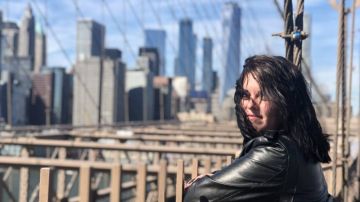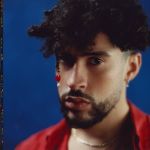I’m Still Exploring My Latina Identity but I Finally Feel Like I’m Enough
The time I spent working at a pizzeria as a teen has blurred over the years, but a few memories stand out: learning how to form little balls of dough so they stay round when you roll them out, practicing the “Crank That” dance on a slow day, racing to hide that we were all

Photo courtesy of Stephanie Aly
The time I spent working at a pizzeria as a teen has blurred over the years, but a few memories stand out: learning how to form little balls of dough so they stay round when you roll them out, practicing the “Crank That” dance on a slow day, racing to hide that we were all reading Harry Potter and the Deathly Hallows when the boss showed up unexpectedly the day after its midnight release. And I remember the guy who called me a “spic.”
He tossed it toward me in that style of casual bigotry that was so commonplace in the aughts, as if his lighthearted chuckle made a racial epithet just another word between friends. I no longer remember my response, but I remember his rebuttal: “Just look at your skin.”
Just look at your skin. I carried the barbed words with me, turning them over one by one, lingering over the way he had elongated “look” as if he really wanted me to pay attention.
What felt even worse was that he had seemed more sure of my identity, my family’s story, my history, than I was. Thanks to the storage bins my mom kept stuffed with binders and documents and fold-out family trees, I knew that on her side I was descended from Dutch and English colonizers of New Amsterdam and New York in the 17th century, and Swiss and Danish immigrants who entered New York in the 19th century. On my dad’s side, I had been told that part of the family was Indigenous Mexican, but never with enough confidence that I would vocally claim that heritage as my own — especially because I didn’t know if family stories about indigenous ancestors were legitimate or the outgrowth of colonization. I became obsessed with finding answers.
If life is a collection of the stories we tell ourselves, mine have historically been written by other people. Like any kid with an unstable home life and a remarkable number of former addresses and phone numbers, I learned early that blending was a tactical move and became a master, adept at changing any aspect of my personality to slide seamlessly into new environments as if I’d been there all along.
And yet, until recently, I shied away from explicitly calling myself Latina or involving myself in community organizations, because I was afraid of taking up space where I was only kind of sure I belonged.
Despite the traditions I had been raised with or the slurs I’d had hurled at me or the gentle eyebrows I often had directed at me when I couldn’t respond to someone’s query in Spanish, I wanted to know that I wasn’t going to inadvertently pull a Hilaria [Baldwin]. I suppose I wanted permission that only I could give myself.
If you spend long enough fashioning an identity out of others’ projections and perceptions, they become your reality, and my reality became “patron saint of confusing white girls.” I’ve heard “Wait, you’re something. What are you?” from strangers often enough that I’ve considered charging for guesses. I inherited my dad’s guilt over our lack of Spanish fluency. Every time I had to fill out a form for school or work I was reminded of this gigantic hole that I had been papering over for my entire life. Do I choose “Hispanic or Latino”? “White (Not Hispanic or Latino)”? “Two or more races (Not Hispanic or Latino)”? What should have been no more complicated than filling in my birth date became a question of existential significance that plagued me throughout my formative years.
I had mostly settled into my uneasy existence of never being quite anything enough when Lisa Kudrow appeared on Late Night with Seth Meyers to promote the show Who Do You Think You Are? Watching Kudrow and Seth Meyers appreciate the threads of history that tie us to our ancestral homelands inspired me to dive back into the melee, determined, this time, to keep going until I had answers.
A Hail Mary involving the 1940 U.S. Census turned up a pivotal puzzle piece in the Rio Grande Valley: Geronimo Sanchez, age 70, listed as living with his grandson, Bobby — my grandfather.
The dominoes fell quickly after that. I barely worked or slept for a week, instead spending my time digging through old newspaper archives and public records, excitedly texting my dad multiple updates a day until I could finally trace nearly every branch of his family back at least a few hundred years. I finally had my answers, and they weren’t all that different from the stories I had been raised with.
As is true for many of us, my family’s story is a complicated one, spanning cultures and continents. You could throw a dart at a map of Western Europe and odds are good that I could tell you about a great-grandparent whose family migrated in the 1800s from wherever the dart lands. And you could do the same in Mexico. I am descended from both colonizers and victims of colonization; there is much left to discover about my ancestors, both those who were Indigenous and the Spanish conquistadores who invaded their homelands, but at least I now know who they were. I know where to start.
Finding my dad’s family was never about breaking my identity down by percentage in that clinical way we tend to do when we’re looking for somewhere to belong. It was about rooting myself in history, about feeling connected in some way to the people who lived and fought and loved so that I would one day have the chance to do the same. I want to know their stories because their lives reach through generations to touch my own. I felt like — I still feel like — I owe it to them to carry their stories with me. To make sure that they aren’t forgotten.
Nothing has changed, really, but I have. Tracking down the ancestors I thought I’d lost, squinting to make out their names on birth records, ship manifests and Census forms, tracing their journeys from the Yucatán Peninsula to New Mexico, from Seville to Mexico City — I was looking for answers about my heritage, but I don’t think I was expecting to find my family. I’ve been distant from most of my family for most of my life; I wasn’t ready for the rush of tears that came when I saw the Geronimo who I’d been told about as a kid listed right above my grandfather’s name on the Census. I was surprised by the pain I felt at the lack of respect afforded my great-great-grandmother, whose name is alternately recorded as Cleofas, Cleo, Ceofes and Ceofas Martinez depending on the document.
Mostly, I was overwhelmed by the sense of wholeness I felt. Going through this process didn’t make me more Latina or less of anything else, but it allowed me to step into the fullness of my identity in a way that I hadn’t understood was possible. It allowed me to celebrate the notes of Mexican American culture that I was raised with as threads that tie me to the past and ground me in the present. It taught me the retrospectively obvious lesson that not having all the answers isn’t grounds for dismissal from the Latinx community.
Families are at least as complicated as the people who form them; we owe it to ourselves and our community to approach identity with curiosity and inclusivity rather than trying to fit everyone into the same stereotypical box. I’m still discovering what it means to embrace the facets of my identity that I’ve historically pushed or had forced below the surface, but I’m finally confident that I belong on the journey.

















